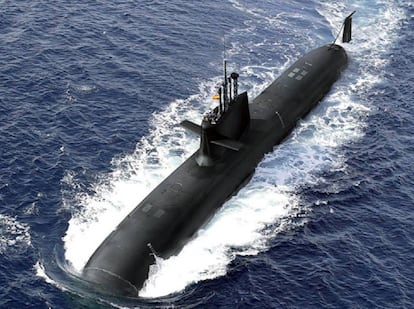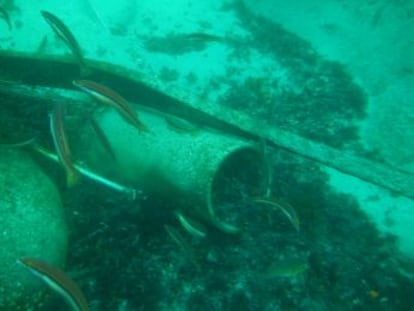New Spanish high-tech submarine has one hitch: it doesn’t fit in its naval base
The cost of every S-80 Plus will come close to €1 billion, almost twice the original amount budgeted

The problems surrounding the bizarre story of the Spanish Navy’s new submarine, the S-80 Plus, have yet to be completely resolved. First, a design flaw meant that the vessel was so heavy that it could not resurface, forcing engineers at the Navantia shipyard to add 10 meters to its length and increase its displacement of water by 800 tons to improve buoyancy.
Now it turns out that this larger version of the S-80 does not fit inside its naval base in Cartagena, in southeastern Spain. This will force the Defense Ministry to enlarge the docking area at a cost of around €16 million.
The program stumbled in 2013, when a weight imbalance cast doubt on whether the submarine would be able to resurface
The Spanish government is due to approve the new spending ceiling for the sub project, bringing the total tab up to €3.9 billion from an initial budget of €2.1 billion. That means that each of the four submarines will come with a price tag of nearly €1 billion, nearly twice as much as initially expected.
Previous ministry officials never got around to approving the new spending guidelines, which means that the team led by the new minister, Margarita Robles of the Socialist Party, needs to fast-track it if it doesn’t want construction to get placed on hold in the fall.
The program stumbled in 2013, when a 125-ton weight imbalance was detected, casting doubt on whether the submarine would be able to resurface.
The Defense Ministry hired a US consulting firm, Electric Boat, which charged €14 million to confirm what experts had diagnosed: that around 10 meters had to be added to the sub’s original length of 71 meters, and that its displacement of water when surfaced had to be raised to 3,000 tons. The new model was called the S-80 Plus.
But one of the collateral effects is that the vessels no longer fit into the docking area of the Cartagena naval base, which can only accommodate lengths of up to 78 meters. For all four subs to to fit, it will be necessary to enlarge the docks and create added infrastructure.
The nearly €1 billion that the Spanish Navy will pay for each S-80 is nearly twice what Israel has paid for German subs
However, the greatest uncertainty lies in the AIP (air-independent propulsion) system, which will give the subs an autonomy somewhere between conventional and nuclear submarines, and allow them to remain underwater for almost two weeks. To avoid further delays, the AIP system will be integrated into the third submarine, whose delivery is scheduled for March 2026. The first two subs, due in 2022 and 2024, will run on diesel propulsion until they are brought in for maintenance toward the end of the decade and fitted with the new technology.
Industry sources said that the success of the S-80 Plus rests on the performance of this Spanish-made AIP system. If all goes well, the S-80 Plus will be a highly competitive product in the conventional sub market, ahead of the German 214. If things go wrong, it will become a failed project, as nobody will want to purchase such a big and indiscreet submarine.
In any event, the state-owned Navantia will have to drastically reduce their price. The nearly €1 billion that the Spanish Navy will pay for each S-80 is nearly twice what Israel has paid for German subs. The market value for this type of submarine is somewhere between €400 and €600 million.
Experts say that such a complex program as this one entails a lot of uncertainty (the final budget earmarks €100 million for unexpected costs), and that the more units get sold, the more of the initial investment will be recouped. But nobody is taking responsibility for the design flaw that has added nearly €1.8 billion to the final cost.
English version by Susana Urra.
Tu suscripción se está usando en otro dispositivo
¿Quieres añadir otro usuario a tu suscripción?
Si continúas leyendo en este dispositivo, no se podrá leer en el otro.
FlechaTu suscripción se está usando en otro dispositivo y solo puedes acceder a EL PAÍS desde un dispositivo a la vez.
Si quieres compartir tu cuenta, cambia tu suscripción a la modalidad Premium, así podrás añadir otro usuario. Cada uno accederá con su propia cuenta de email, lo que os permitirá personalizar vuestra experiencia en EL PAÍS.
¿Tienes una suscripción de empresa? Accede aquí para contratar más cuentas.
En el caso de no saber quién está usando tu cuenta, te recomendamos cambiar tu contraseña aquí.
Si decides continuar compartiendo tu cuenta, este mensaje se mostrará en tu dispositivo y en el de la otra persona que está usando tu cuenta de forma indefinida, afectando a tu experiencia de lectura. Puedes consultar aquí los términos y condiciones de la suscripción digital.
More information
Archived In
Últimas noticias
Reinhard Genzel, Nobel laureate in physics: ‘One-minute videos will never give you the truth’
Pinochet’s victims grapple with José Antonio Kast’s rise in Chile
From digital curfews to blocking apps: How technology experts protect their children online
Why the price of coffee has skyrocketed: from Brazilian plantations to specialty coffee houses
Most viewed
- Pablo Escobar’s hippos: A serious environmental problem, 40 years on
- Why we lost the habit of sleeping in two segments and how that changed our sense of time
- Trump’s obsession with putting his name on everything is unprecedented in the United States
- Charles Dubouloz, mountaineering star, retires at 36 with a farewell tour inspired by Walter Bonatti
- The Florida Keys tourist paradise is besieged by immigration agents: ‘We’ve never seen anything like this’











































